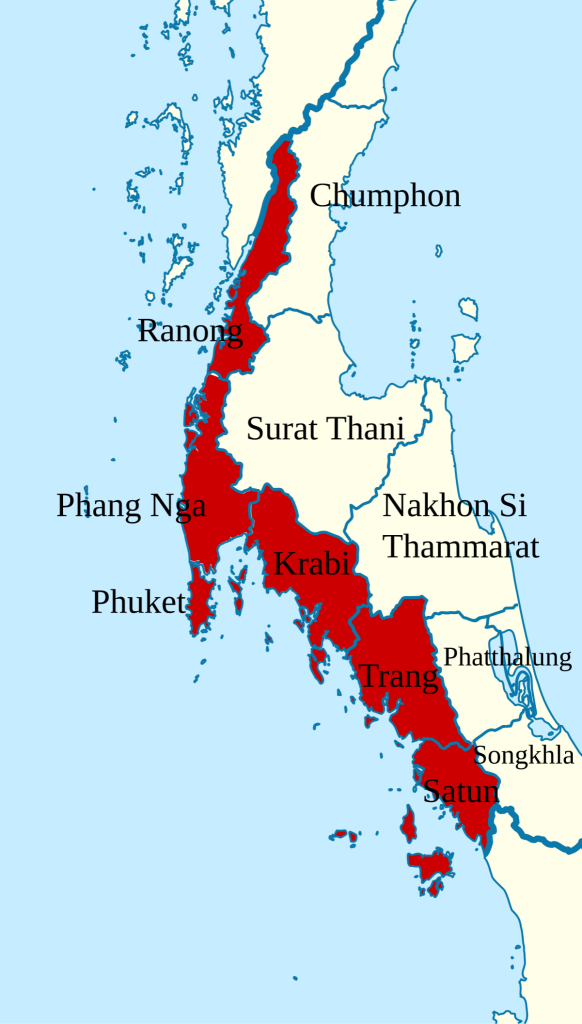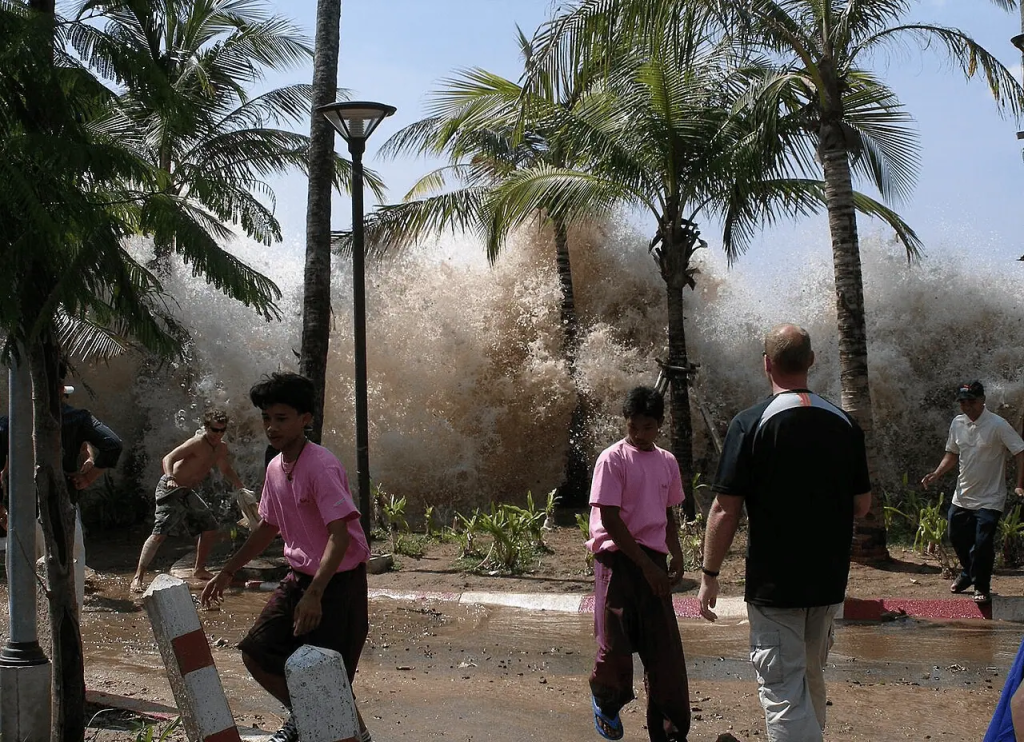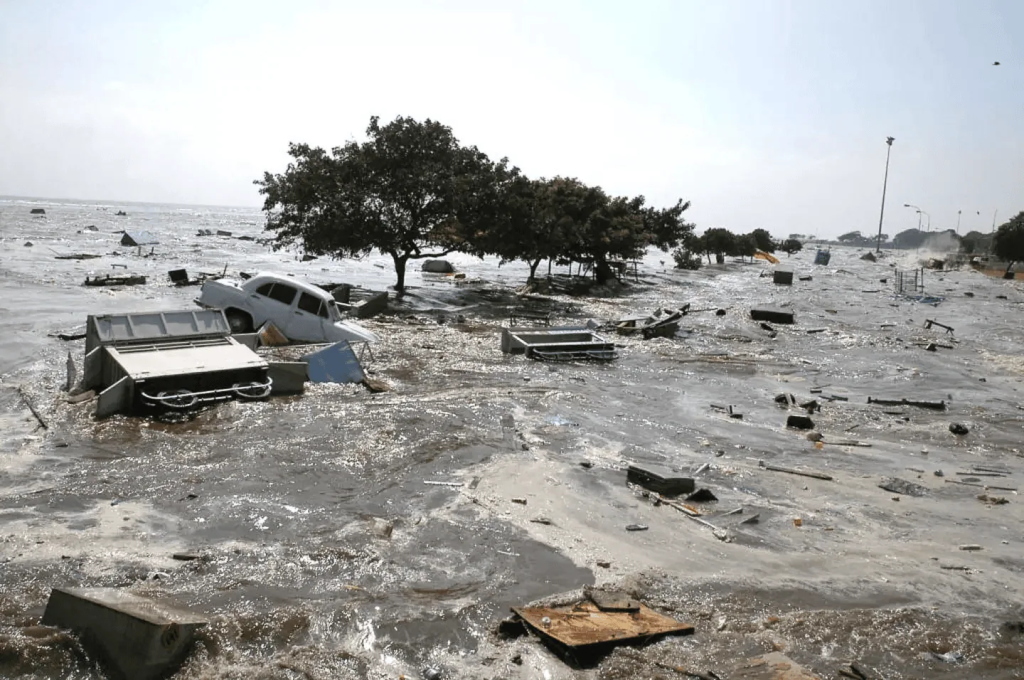Tsunami in Thailand 2004: A Disaster That Changed the World
December 26, 2004, became a day of immense tragedy for Asia and the entire world. At 07:58 a.m. local time, an undersea earthquake with a magnitude of 9.1–9.3 struck in the Indian Ocean. This triggered the formation of giant tsunami waves that claimed the lives of approximately 300,000 people. Among the hardest-hit countries was Thailand.
The Beginning — The Morning Before the Tsunami
An ordinary December morning began with an earthquake deep in the Indian Ocean near the Indonesian island of Simeulue. The seismic shocks, with a magnitude of 9.1–9.3, displaced massive volumes of water. In the open ocean, this appeared as low, semicircular ripples moving at speeds of up to 1,000 km/h. The waves headed toward the coasts of Thailand, Indonesia, Sri Lanka, and even Africa.
As they approached shallow waters, the speed of the waves decreased, but their height increased dramatically. In some areas, the water reached heights of 40 meters. These waves carried energy equivalent to two atomic bombs dropped on Hiroshima and Nagasaki. For those on the shorelines, it all happened suddenly and without warning.
The Devastating Strike
At that time, residents and tourists along Thailand’s western coast (Phuket, Krabi, and nearby smaller islands) were going about their daily routines: some were heading to work, others were relaxing by the sea, and some were still asleep. The underground tremors were not felt on land, and no one suspected the impending catastrophe. About an hour after the earthquake, strange phenomena began to unfold along the coast:
- Animals and birds fled the area in panic.
- The surf fell eerily silent, and the sea suddenly receded from the shore.
- Intrigued by what was happening, people ventured onto the exposed seabed, collecting shells and fish, unaware that these were the first signs of a tsunami.
When a 15-meter wall of water approached, it was noticed too late. Lacking a white crest, the wave blended with the ocean horizon for a long time. As it crashed down, the sea roared deafeningly, beginning to destroy everything in its path. The waves unleashed devastating torrents of water, tearing down buildings, sweeping away cars, and turning everything into chaos.
The Tsunami in Thailand
The ocean surged hundreds of meters inland, and in some places up to two kilometers. As the waves retreated, they posed no less danger, dragging debris with them: concrete, metal structures, furniture, and high-voltage cables. These deadly currents threatened the life of anyone caught in their path.
The 2004 Tsunami in Thailand: Overview
On December 26, 2004, a 9.1-9.3 magnitude earthquake struck off the coast of Aceh, Indonesia, generating tsunamis that ravaged Thailand’s western coast. The tsunamis, traveling at speeds up to 800 km/h, reached Thailand within one to two hours, causing widespread destruction in provinces like Phang Nga, Phuket, Krabi, and Trang. The disaster resulted in approximately 5,395 deaths, with 2,817 being foreign tourists, and impacted 407 villages, completely destroying 47 of them. Khao Lak, a popular tourist destination, saw the highest tsunami wave run-up outside Sumatra, with deaths potentially exceeding 4,500. The Thai government and international aid organizations responded with relief efforts, leading to the establishment of a tsunami warning system.
Impact on Specific Areas
The tsunamis hit various regions differently:
- Phuket Island: Beaches like Patong and Kata suffered significant damage, with 259 deaths, 1,111 injured, and 700 missing.
- Khao Lak: Almost completely destroyed, with the ‘disappearing sea effect’ causing many deaths as people approached the receding sea. Death toll estimates are around 3,950, possibly over 4,500.
- Ban Nam Khem: Lost 25% of its 4,200 population and 80% of homes.
- Other provinces like Krabi and Ranong also saw considerable casualties and damage.

Response and Recovery
Following the disaster, emergency shelters, medical aid, and food supplies were provided. Reconstruction efforts improved coastal resilience, and a tsunami warning system was established to prevent future tragedies.
The 2004 Tsunami in Thailand: A Detailed Survey Note
The 2004 Indian Ocean earthquake and tsunami, occurring on December 26, 2004, stands as one of the deadliest natural disasters in modern history, with profound impacts on Thailand. This survey note provides a comprehensive analysis, drawing from multiple sources to detail the event, its effects, and the subsequent response, ensuring a thorough understanding for researchers, policymakers, and the public.
Geological Origins and Event Timeline
The disaster was initiated by a massive undersea earthquake at 7:58:53 local time (UTC+7), with a magnitude ranging from 9.1 to 9.3, off the west coast of Aceh, Indonesia. This earthquake, known scientifically as the Sumatra-Andaman earthquake, resulted from the subduction of the Indian Plate under the Eurasian Plate along the Sumatra-Andaman trench. The rupture extended over 1,300 kilometers and lasted approximately 10 minutes, displacing the ocean floor and generating tsunamis that traveled at speeds estimated between 700 to 1,000 km/h in deep water.
The tsunamis reached Thailand’s western coast within one to two hours, with the first signs noticed at the Similan Islands, located about 70 km from Phang Nga town and 13 km from central Khao Lak. The waves then impacted the mainland, particularly affecting Phang Nga, Phuket, Krabi, Ranong, Satun, and Trang provinces. Initial calculations based on distance (e.g., approximately 650 km from the epicenter to Phuket) and tsunami speed suggest arrival times around 8:48 a.m. local time, though exact timings vary by location and are not uniformly documented in available sources.

Detailed Impact on Thai Provinces
The devastation was widespread, with specific areas experiencing catastrophic damage:
- Similan Islands: Reported strong currents and turbulence by divers, with some inland flooding but no casualties, highlighting the initial impact on offshore locations.
- Phuket Island: The west coast, including major beaches like Kamala, Patong, Karon, and Kata, suffered substantial damage. Official figures indicate 259 deaths, with 154 Thai and 105 foreign nationals, 1,111 injured (591 Thai, 520 foreign), and 700 missing. The area, a significant tourist hub, saw around 250 total deaths, including many foreign tourists.
- Khao Lak (Phang Nga Province): This resort town, 80 km north of Phuket, was among the most severely affected, with low-lying bungalows and flat terrain (few meters above sea level) exacerbating the impact. The tsunami wave run-up was the highest outside Sumatra, and the ‘disappearing sea effect’—where the sea receded unusually far, luring people to the water’s edge—contributed to high casualties. Estimates suggest around 3,950 deaths, potentially exceeding 4,500, with significant destruction of the coastal landscape. Notable incidents include the beaching of the Thai navy boat 813, found 1.25 km inland at Bang Niang Beach, now part of a museum exhibit.
- Ban Nam Khem (north of Khao Lak): This fishing community lost 25% of its 4,200 population and saw 80% of homes destroyed, underscoring the vulnerability of coastal villages.
- Takua Pa District (Phang Nga Province): Severely affected, with significant casualties, including many Burmese laborers, reflecting the diverse demographic impact.
- Other Provinces: Detailed provincial figures as of January 7, 2005, from the Bangkok Post, provide a comprehensive breakdown:
| Province | Thai Deaths | Foreign Deaths | Total Deaths | Thai Injured | Foreign Injured | Total Injured | Missing |
|---|---|---|---|---|---|---|---|
| Krabi | 288 | 188 | 476 | 808 | 568 | 1,376 | 890 |
| Phang Nga | 1,950 | 2,213 | 4,163 | 4,344 | 1,253 | 5,597 | 2,113 |
| Phuket | 154 | 105 | 259 | 591 | 520 | 1,111 | 700 |
| Ranong | 167 | 2 | 169 | 215 | 31 | 246 | 12 |
| Satun | 6 | 0 | 6 | 15 | 0 | 15 | 0 |
| Trang | 3 | 2 | 5 | 92 | 20 | 112 | 1 |
The total death toll was 5,078, with 8,457 injured and 3,716 missing across these provinces, reflecting the scale of the human tragedy. Infrastructure damage included the destruction of over 500 fishing boats and 10 trawlers, severely impacting the fishing and tourism sectors, which are vital to the local economy. Public aversion to consuming locally caught fish from Andaman Sea ports due to contamination fears further affected sales and livelihoods.
Human and Economic Consequences
The disaster killed approximately 5,395 people in Thailand, with 2,817 being foreign tourists, underscoring the international dimension of the tragedy. The impact on tourism was profound, with popular resorts like Khao Lak and Phuket seeing significant loss of infrastructure. The economic fallout included disrupted commerce and living conditions, particularly in coastal provinces, with long-term effects on the tourism and fishing industries.

Personal stories, such as that of Neungduangjai Sritrakarn, who escaped with her family after her mother noticed unusual sea patterns, and American survivors like Chris Xaver and Scott Weatherby, who endured harrowing experiences, highlight the human element. Xaver described being underwater for up to two minutes, sustaining injuries requiring 50 stitches, illustrating the intensity of the event.
Response and Recovery Efforts
In the immediate aftermath, the Thai government, supported by international aid organizations like World Vision, launched a massive relief effort. Emergency shelters, medical aid, and food supplies were distributed to displaced populations. Reconstruction efforts focused on rebuilding damaged infrastructure, with opportunities to redesign tourist areas like Patong Beach in a more aesthetically and environmentally suitable way.
Political dimensions emerged during the legislative elections on February 6, 2005, with Prime Minister Thaksin Shinawatra accusing the previous government of ignoring tsunami risk warnings from 1998, a claim supported by the former head of the Meteorological Department, Smith Tumsaroch. This politicization highlighted the need for improved disaster preparedness.
Long-term recovery included the establishment of tsunami shelters and a sophisticated alarm system, providing a two-hour warning for future events, ample time to reach higher ground. The installation of an early-warning system along the affected coastline was a direct response to the lack of such measures in 2004, which contributed to the high death toll due to the absence of prior alerts.
Lessons Learned and Preparedness
The 2004 tsunami was a catalyst for change, particularly in tsunami preparedness. Prior to the event, tsunami risk in the region was considered low, and no warning system existed. The disaster prompted the development of the Indian Ocean Tsunami Warning System, emphasizing the need for better communications networks and public understanding of tsunami hazards. Researchers noted that many lives could have been saved with timely warnings, a lesson painfully learned and now integrated into global disaster management strategies.
Memorials, such as the Tsunami Memorial Park at Ban Nam Khem, continue to honor the victims, with events marking the 20th anniversary in 2024 reflecting ongoing grief and remembrance. The event’s legacy includes increased funding and development for early-warning systems, as discussed in scientific conferences like the American Geophysical Union annual meeting in 2024.
Methodological Notes
This analysis relied on multiple sources, including Wikipedia pages for the earthquake and its effects on Thailand (2004 Indian Ocean earthquake and tsunami, Effect of the 2004 Indian Ocean earthquake on Thailand), Britannica for factual overviews (Indian Ocean tsunami of 2004), and news articles from History.com (The 2004 Tsunami Wiped Away Towns With ‘Mind-Boggling’ Destruction) and World Vision (2004 Indian Ocean earthquake and tsunami: Facts and FAQs). Web searches and page browsing were used to gather specific details, such as provincial death tolls and damage reports, ensuring a comprehensive dataset.
The initial approach involved recalling the event’s basics, followed by web searches for “2004 Tsunami in Thailand” and “tsunami arrival time in Phuket 2004” to refine timelines and impacts. A browse_page action on the Wikipedia effect page provided detailed provincial data, confirming casualty figures and damage specifics. Discrepancies, such as varying death toll estimates (e.g., 5,400 vs. 5,395), were resolved by prioritizing official figures from the Bangkok Post as of January 7, 2005.
This survey note aims to be a complete and self-contained document, offering insights for disaster management and historical analysis, with all relevant information included for a thorough understanding of the 2004 tsunami’s impact on Thailand.